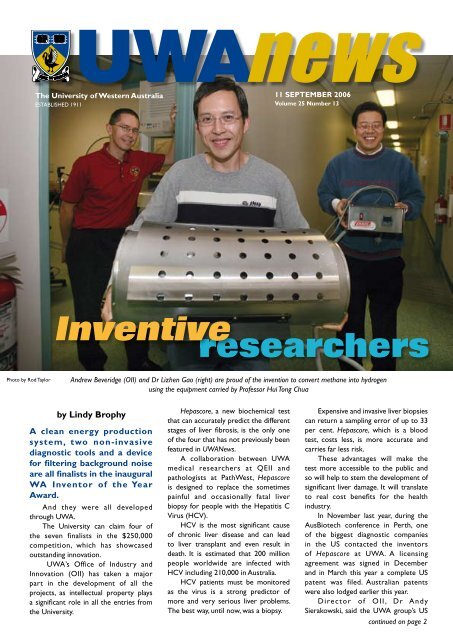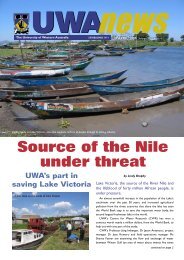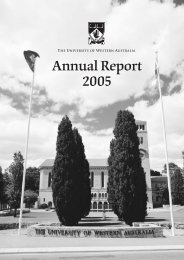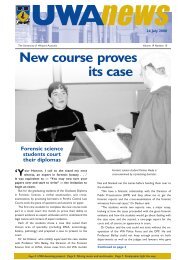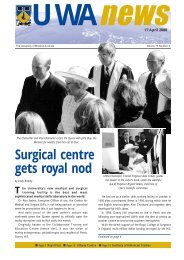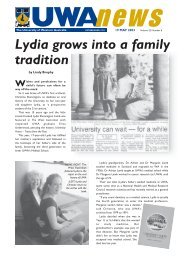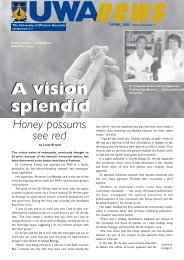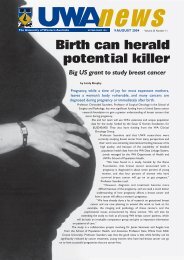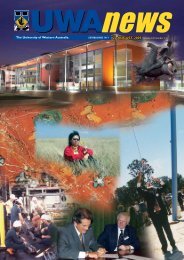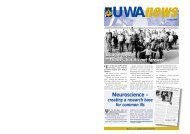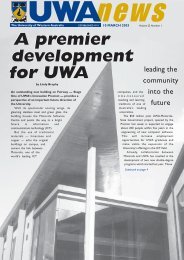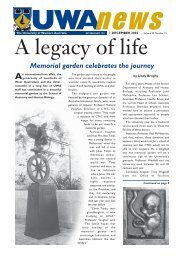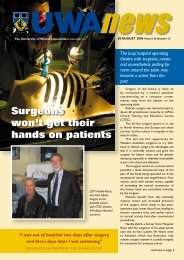11 Sept: Vol 25, #13 - UWA News staff magazine - The University of ...
11 Sept: Vol 25, #13 - UWA News staff magazine - The University of ...
11 Sept: Vol 25, #13 - UWA News staff magazine - The University of ...
Create successful ePaper yourself
Turn your PDF publications into a flip-book with our unique Google optimized e-Paper software.
<strong>UWA</strong>news<br />
<strong>The</strong> <strong>University</strong> <strong>of</strong> Western Australia<br />
<strong>11</strong> SEPTEMBER 2006<br />
<strong>Vol</strong>ume <strong>25</strong> Number 13<br />
ESTABLISHED 19<strong>11</strong><strong>UWA</strong><br />
inventive<br />
researchers<br />
Photo by Rod Taylor<br />
Andrew Beveridge (OII) and Dr Lizhen Gao (right) are proud <strong>of</strong> the invention to convert methane into hydrogen<br />
using the equipment carried by Pr<strong>of</strong>essor Hui Tong Chua<br />
by Lindy Brophy<br />
A clean energy production<br />
system, two non-invasive<br />
diagnostic tools and a device<br />
for filtering background noise<br />
are all finalists in the inaugural<br />
WA Inventor <strong>of</strong> the Year<br />
Award.<br />
And they were all developed<br />
through <strong>UWA</strong>.<br />
<strong>The</strong> <strong>University</strong> can claim four <strong>of</strong><br />
the seven finalists in the $<strong>25</strong>0,000<br />
competition, which has showcased<br />
outstanding innovation.<br />
<strong>UWA</strong>’s Office <strong>of</strong> Industry and<br />
Innovation (OII) has taken a major<br />
part in the development <strong>of</strong> all the<br />
projects, as intellectual property plays<br />
a signifi cant role in all the entries from<br />
the <strong>University</strong>.<br />
Hepascore, a new biochemical test<br />
that can accurately predict the different<br />
stages <strong>of</strong> liver fi brosis, is the only one<br />
<strong>of</strong> the four that has not previously been<br />
featured in <strong>UWA</strong><strong>News</strong>.<br />
A collaboration between <strong>UWA</strong><br />
medical researchers at QEII and<br />
pathologists at PathWest, Hepascore<br />
is designed to replace the sometimes<br />
painful and occasionally fatal liver<br />
biopsy for people with the Hepatitis C<br />
Virus (HCV).<br />
HCV is the most signifi cant cause<br />
<strong>of</strong> chronic liver disease and can lead<br />
to liver transplant and even result in<br />
death. It is estimated that 200 million<br />
people worldwide are infected with<br />
HCV including 210,000 in Australia.<br />
HCV patients must be monitored<br />
as the virus is a strong predictor <strong>of</strong><br />
more and very serious liver problems.<br />
<strong>The</strong> best way, until now, was a biopsy.<br />
Expensive and invasive liver biopsies<br />
can return a sampling error <strong>of</strong> up to 33<br />
per cent. Hepascore, which is a blood<br />
test, costs less, is more accurate and<br />
carries far less risk.<br />
<strong>The</strong>se advantages will make the<br />
test more accessible to the public and<br />
so will help to stem the development <strong>of</strong><br />
signifi cant liver damage. It will translate<br />
to real cost benefi ts for the health<br />
industry.<br />
In November last year, during the<br />
AusBiotech conference in Perth, one<br />
<strong>of</strong> the biggest diagnostic companies<br />
in the US contacted the inventors<br />
<strong>of</strong> Hepascore at <strong>UWA</strong>. A licensing<br />
agreement was signed in December<br />
and in March this year a complete US<br />
patent was filed. Australian patents<br />
were also lodged earlier this year.<br />
Director <strong>of</strong> OII, Dr Andy<br />
Sierakowski, said the <strong>UWA</strong> group’s US<br />
continued on page 2
2 <strong>UWA</strong>news<br />
continued from page 1<br />
Kids<br />
start<br />
research<br />
Pr<strong>of</strong>essor Yogesan demonstrates his teleophthalmology kit, Eyescan, to NASA’s<br />
Dr Rafat Ansari at the Lions Eye Institute<br />
partner expected to commercialise and start marketing <strong>of</strong> the diagnostic tool in the<br />
US later this year.<br />
<strong>The</strong> other diagnostic tool which is a fi nalist in the Government-sponsored<br />
competition is Pr<strong>of</strong>essor Kanagasingam Yogesan’s portable non-invasive easy-tooperate<br />
device for detecting eye disease.<br />
Eyescan was developed initially for use in rural and remote regions and can be<br />
operated by non-medical people with minimal training. Results are relayed through<br />
computers. Pr<strong>of</strong>essor Yogesan and his research team at the Lions Eye Institute are<br />
trailblazers in telemedicine and teleophthalmology.<br />
<strong>The</strong>ir technology is being considered by NASA for possible adaptation for the<br />
manned mission to Mars.<br />
Sensear, a system that blocks out background noise while making it possible to<br />
communicate with people close by, has been developed by the Western Australian<br />
Telecommunications Research Institute (WATRI), a collaboration between <strong>UWA</strong><br />
and Curtin <strong>University</strong> <strong>of</strong> Technology, that is based at <strong>UWA</strong>.<br />
It could become invaluable for people working in dangerously noisy<br />
environments such as mines, factories and nightclubs with extremely loud music.<br />
OII helped WATRI to develop a prototype unit with funding from its Pathfi nder<br />
program. <strong>The</strong> spin-<strong>of</strong>f company Sensear was then created and its CEO, Justin Miller,<br />
has been demonstrating it around the world. Dr Sierakowski said several licensing<br />
deals for Sensear were expected in 2007 and beyond.<br />
A process for converting methane into hydrogen and graphite has been<br />
developed by Associate Pr<strong>of</strong>essor Hui Tong Chua and his team from the School <strong>of</strong><br />
Mechanical Engineering.<br />
It is a clean way <strong>of</strong> providing energy for future generations, particularly for<br />
transport.<br />
“Our proposed technique avoids<br />
the production <strong>of</strong> greenhouses gases<br />
and, instead engenders high value-added<br />
graphitized carbon as a by-product,” A/<br />
Pr<strong>of</strong>essor Chua said.<br />
<strong>The</strong> graphite by-product is very<br />
valuable to industry, being used, for<br />
example, as a separator for mobile<br />
phone batteries.<br />
<strong>The</strong> project has two industry<br />
partners, Wesfarmers and US company<br />
xL Tech Group, and it is expected a<br />
licensing deal will result next year.<br />
<strong>The</strong> winners <strong>of</strong> the WA Inventor <strong>of</strong><br />
the Year Award will be announced on<br />
<strong>Sept</strong>ember 15.<br />
Sensear CEO Justin Miller has<br />
demonstrated Sensear world-wide<br />
early<br />
on<br />
Saturday<br />
mornings<br />
THE UNIVERSITY OF WESTERN AUSTRALIA • <strong>11</strong> SEPTEMBER 2006
<strong>UWA</strong>news 3<br />
Saturday mornings in the School <strong>of</strong> Music prove<br />
that small people can make very big sounds.<br />
It is one <strong>of</strong> the noisiest times <strong>of</strong> the week, as up to<br />
180 children, aged between 18 months and 12 years,<br />
take part in the Junior Music School (JMS).<br />
<strong>The</strong> classes have been operating for about 10<br />
years but the JMS has been recently expanded, after<br />
a review last year found a huge demand for a music<br />
program where children can begin as toddlers and<br />
continue through the program until they reach tertiary level.<br />
Until this year, the youngest participants were three years<br />
A fresh wind recording<br />
Sometimes you do have to suffer for your<br />
art.<br />
Staff and graduates from the School <strong>of</strong> Music have<br />
recorded a CD, recently released by ABC Classics, and<br />
shivered their way through some <strong>of</strong> the pieces <strong>of</strong> music.<br />
<strong>The</strong> Australian Classical Wind Band was partly recorded<br />
in Winthrop Hall and partly in the big hall at the old<br />
Sunset property on the riverfront at Dalkeith.<br />
“<strong>The</strong> acoustics are brilliant there,” said Head <strong>of</strong><br />
School, Darryl Poulsen, who plays the French horn and<br />
performed on one <strong>of</strong> the historical instruments featured<br />
on the CD. “But it was freezing, and when we turned the<br />
heating on, it made such a noise that we had to turn it <strong>of</strong>f<br />
again, and suffer in the cold.”<br />
old and they could stay in the program until they were 10.<br />
Now, parents can come to Music Playground classes with<br />
their children from the time they are 18 months old.<br />
When children progress through toddlers, prekindergarten<br />
and kindergarten programs, they then start to<br />
come to Soundscapes classes on their own, to develop their<br />
musical self-confi dence.<br />
<strong>The</strong>y learn to play recorder and keyboard at a very<br />
young age, depending on their competence, and can quickly<br />
progress to violin, guitar, fl ute and higher levels <strong>of</strong> piano.<br />
Children join group instrumental lessons with a<br />
maximum <strong>of</strong> four children in each class. Once they have<br />
completed a year <strong>of</strong> group instrumental classes, they can<br />
progress, if they interested, to individual lessons, in which<br />
they receive expert tuition from some <strong>of</strong> the <strong>University</strong>’s<br />
pr<strong>of</strong>essional musicians.<br />
All children enrolled in JMS have the option <strong>of</strong> joining<br />
a choir or a percussion ensemble, once they have reached<br />
a certain competency. <strong>The</strong> choir brings together children<br />
aged seven to <strong>11</strong> and the percussion group is for fi ve to<br />
<strong>11</strong>-year-olds.<br />
Students sometimes sit in on rehearsals <strong>of</strong> the WA<br />
Youth Orchestra and are visited by musical experts in<br />
specialist areas.<br />
<strong>The</strong> new JMS manager, Donna Brookes, said parents<br />
had confi dence in sending their children to a <strong>University</strong>run<br />
program, with access to the latest research, the best<br />
teaching methods and curriculum.<br />
“Our teachers are not only well qualified and expert at<br />
working with children, they are also dedicated, pr<strong>of</strong>essional<br />
and passionate about their work,” Donna said.<br />
Involvement in music<br />
helps children to develop their<br />
creativity, problem-solving skills,<br />
memory, behaviour, maths,<br />
languages and social skills.<br />
For more information<br />
about JMS visit their website:<br />
www.music.uwa.edu.au/junior_<br />
music_school or email jms@<br />
uwa.edu.au<br />
<strong>The</strong> CD features harmonie (or wind ensemble) music<br />
from Mozart and Beethoven on historical instruments<br />
now owned by the <strong>University</strong>.<br />
“It’s the fi rst time this repertoire has been recorded<br />
on period instruments in Australia,” Mr Poulsen said.<br />
It was fi tting that Deputy Vice-Chancellor Pr<strong>of</strong>essor<br />
Margaret Seares launched the CD as it was she who had<br />
written the grant application for the School to buy the<br />
instruments many years ago when she had been Head <strong>of</strong><br />
the School <strong>of</strong> Music.<br />
Peter Moore, the School’s Director <strong>of</strong> Wind Studies,<br />
also performs on the CD, playing the bassoon, as does<br />
former <strong>UWA</strong> <strong>staff</strong> member Ge<strong>of</strong>frey Lancaster, along with<br />
several graduates. <strong>The</strong> CD is available from ABC Shops.<br />
THE UNIVERSITY OF WESTERN AUSTRALIA • <strong>11</strong> SEPTEMBER 2006
Vice-Chancellor’s<br />
column<br />
Meeting our<br />
growth targets<br />
<strong>The</strong> size and shape <strong>of</strong> our<br />
university sets the foundation<br />
from which we are able to<br />
achieve our overall strategic<br />
and operational goals.<br />
It is therefore something which<br />
we constantly monitor and guide,<br />
intervening where necessary to<br />
ensure we remain on track.<br />
<strong>The</strong>se are matters which were<br />
considered at the last Senate meeting<br />
in a discussion which was focused by<br />
two excellent papers prepared by<br />
our Registrar, Peter Curtis, and the<br />
Director <strong>of</strong> Planning Services, Robert<br />
McCormack.<br />
In essence, the assessment<br />
presented indicated that the<br />
<strong>University</strong>’s enrolment and load are<br />
generally increasing in a direction that<br />
is consistent with our aim to reach an<br />
enrolment target <strong>of</strong> 20,000 by 2010<br />
(a target set in 2000). However, there<br />
remain some key challenges, notably<br />
growing the number <strong>of</strong> higher degree<br />
by research (HDR) students.<br />
Our aim has been for a course<br />
mix <strong>of</strong> 70:30 undergraduate to<br />
postgraduate; with a further mix in<br />
the postgraduate area <strong>of</strong> 18 per cent<br />
HDR and 12 per cent postgraduate<br />
coursework. Our best estimates<br />
are that while numbers continue<br />
to grow towards our 2010 target,<br />
the mix will remain substantially as<br />
it is now: 12 percent HDR, 12 per<br />
cent coursework and 76 per cent<br />
undergraduate students.<br />
Aussies prove the best<br />
Pr<strong>of</strong>essor Cheryl Praeger is the first Australian<br />
to be elected to the executive committee <strong>of</strong> the<br />
International Mathematical Union.<br />
<strong>The</strong> IMU is the international umbrella organisation for<br />
research and education in mathematics, responsible for the<br />
International Congress <strong>of</strong> Mathematicians and the awarding<br />
<strong>of</strong> the Fields Medals.<br />
Pr<strong>of</strong>essor Praeger’s election was announced at the<br />
General Assembly in Santiago de Compostela in Spain. She<br />
will be a Member-at-Large for four years from January 2007.<br />
<strong>UWA</strong>news<br />
T h i s i n p a r t r e f l e c t s<br />
Commonwealth Government policy<br />
which puts a priority on the funding<br />
<strong>of</strong> undergraduate places, as well as the<br />
impact <strong>of</strong> a very buoyant economy<br />
which makes it difficult to recruit highquality<br />
postgraduate students.<br />
<strong>The</strong> <strong>University</strong>’s response has been<br />
to try to boost our HDR enrolments<br />
through a more aggressive scholarships<br />
policy, both injecting significant<br />
additional money into scholarships and<br />
making more flexible arrangements<br />
for faculty matching scholarships and<br />
fee-waivers for international research<br />
students. <strong>The</strong> Postgraduate Research<br />
and Scholarships Office has also<br />
extended its effort to target honours<br />
students in the <strong>University</strong>’s schools<br />
to encourage more to consider<br />
postgraduate research.<br />
Po s t g r a d u a t e c o u r s e w o r k<br />
enrolments remain a potential growth<br />
area for this <strong>University</strong> which has<br />
a relatively low proportion <strong>of</strong> its<br />
enrolments in this category compared<br />
with other Australian Group <strong>of</strong><br />
Eight universities. <strong>The</strong>re is potential<br />
Alan Robson<br />
Vice-Chancellor<br />
to increase both domestic<br />
and international numbers if<br />
postgraduate coursework programs<br />
are designed to better meet<br />
demand for pr<strong>of</strong>essional education<br />
and to complement our research<br />
strengths and activities, provided<br />
appropriate funding arrangements<br />
support this strategy.<br />
As the Registrar’s paper<br />
pointed out, articulated graduate<br />
programs can serve both these<br />
markets (<strong>of</strong> continuing pr<strong>of</strong>essional<br />
education and preparation for<br />
higher degree research), and there<br />
is evidence that in the international<br />
market, postgraduate coursework<br />
is growing significantly in part as<br />
preparation for research degree<br />
enrolment. Locally, there is an<br />
opportunity to tailor programs<br />
to the need for skills upgrading<br />
through concentrated and/or parttime<br />
programs.<br />
In the area <strong>of</strong> undergraduate<br />
courses, the latest data indicates<br />
that our school-leaver preferences<br />
in 2005-06 have been stronger<br />
than ever despite our cut-<strong>of</strong>f<br />
entry scores rising relative to<br />
other WA Universities. Central<br />
to this success rate has been our<br />
energetic recruitment program<br />
and a substantial increase in<br />
undergraduate scholarships.<br />
<strong>The</strong> progress towards our<br />
targets is generally pleasing and<br />
suggests that the aim we set six<br />
years ago <strong>of</strong> achieving funded<br />
growth commensurate with our<br />
high-quality teaching and research<br />
character remains the appropriate<br />
way to proceed.<br />
Her colleagues are delighted that Pr<strong>of</strong>essor Praeger’s<br />
election recognises her contributions to mathematics.<br />
<strong>The</strong>y include an invited talk at the International Congress<br />
<strong>of</strong> Mathematicians in Beijing, being one <strong>of</strong> the world’s most<br />
highly cited mathematicians (according to ICI Citations),<br />
a Member <strong>of</strong> the Order <strong>of</strong> Australia and a Fellow <strong>of</strong> the<br />
Australian Academy <strong>of</strong> Science.<br />
Pr<strong>of</strong>essor Michael Cowling, President <strong>of</strong> the Australian<br />
Mathematics Society, said that Pr<strong>of</strong>essor Praeger’s election was<br />
indicative <strong>of</strong> the respect that Australian mathematics enjoys<br />
internationally. And the awarding <strong>of</strong> the prestigious Fields Medal<br />
for 2006 to young Adelaide-educated mathematician Terry Tao<br />
in the same week is further pro<strong>of</strong>.<br />
THE UNIVERSITY OF WESTERN AUSTRALIA • <strong>11</strong> SEPTEMBER 2006
<strong>UWA</strong>news 5<br />
sea<br />
scapes<br />
Bombing (2005) by Narelle Autio<br />
It’s not all rolling waves and pristine beaches<br />
in the Lawrence Wilson Art Gallery’s<br />
current exhibition Picturing the Sea.<br />
Curator Janice Baker has brought together<br />
an extraordinarily diverse collection <strong>of</strong> paintings,<br />
photographs and sculptures, representing connections<br />
with the sea that will surprise most visitors.<br />
Indigenous artist Ben Pushman has created an<br />
abstract acrylic on canvas called Scar #40, that blends<br />
the lines <strong>of</strong> the ocean with the scars <strong>of</strong> traditional<br />
scarification. <strong>The</strong> painting captures, for the artist,<br />
memories <strong>of</strong> his grandfather, who was a stoker on a<br />
battleship.<br />
<strong>The</strong> ocean has been the scene <strong>of</strong> countless battles<br />
and confl icts. Max Pam’s startling photograph <strong>of</strong> ships<br />
beached on a pristine tropical beach (On the Waterfront<br />
Dar Es Salaam ) illustrates the drama <strong>of</strong> the relationship<br />
between the ocean and these confl icts.<br />
Grace Cossington Smith’s oil painting Dawn Landing<br />
shows how young most soldiers are. One <strong>of</strong> the freshfaced<br />
boys disembarking in a foreign land, ready for<br />
battle, is her nephew, who never came home from<br />
his war. This painting is from the Cruthers Collection,<br />
which concentrates on Australian women artists.<br />
But there is fun and nostalgia in this exhibition<br />
too. Patricia Piccinini’s photographic series Sandman<br />
(2002) recalls the days <strong>of</strong> the panel van with the iconic<br />
bleached blonde surfer sitting inside, waiting patiently<br />
for a wave (Quiet Refl ection).<br />
Bombing captures the moment, underwater, when<br />
a young man who has jumped into the sea holds his<br />
breath to rise to the surface. An evocative image by<br />
Walkley Award-winning photographer Narelle Autio, it<br />
is from the Christ Church Grammar School Foundation<br />
Art Collection.<br />
Local artist Jeremy Kirwan-Ward captures the sea<br />
in acrylic on canvas and one <strong>of</strong> his paintings in particular,<br />
Ripples on the Surface, from the Wesfarmers Collection,<br />
is so realistic that you can’t believe it’s a fl at surface<br />
until you get really close.<br />
East Timorese artist Maria Madeira has an<br />
installation, Tasi Mane (Southern Ocean),concocted<br />
from palm fronds, smooth pebbles and frayed rope, that<br />
communicates her wish for the people <strong>of</strong> Timor Leste<br />
to receive a fair deal out <strong>of</strong> the oil and gas reserves <strong>of</strong>f<br />
their shores.<br />
<strong>The</strong> exhibition is made up <strong>of</strong> works from public<br />
and private collections as well as works from the<br />
<strong>University</strong>’s collection.<br />
A tiny gouache, Fishermen, by William Dobell, is one<br />
<strong>of</strong> <strong>UWA</strong>’s paintings, as is Picnic at Newquay by Charles<br />
Condor, both about 100 years old.<br />
Two old charts from the Kerry Stokes Collection<br />
show mythical marine monsters in the oceans <strong>of</strong> the<br />
world but, in 1571 and even in 1723, there is not much<br />
<strong>of</strong> Australia on the world maps, other than a vague<br />
northern coastline.<br />
Picturing the Sea runs until October .<br />
THE UNIVERSITY OF WESTERN AUSTRALIA • <strong>11</strong> SEPTEMBER 2006
<strong>UWA</strong>news<br />
Science Communication students have investigated<br />
a new method, being used by two Forensic Science<br />
PhD candidates, to detect fraud in the turbulent art<br />
world.<br />
<strong>The</strong>ir stories about Emma Bartle, Rachel Green and<br />
Laser Ablation Inductively Coupled Plasma Mass<br />
Spectrometry are on these pages.<br />
<strong>UWA</strong>news will feature two more stories from Science<br />
Communication students in the next issue.<br />
Course co-ordinator Dr Nancy Longnecker is always on the<br />
look-out for scientists on campus who are willing to talk to<br />
Science Communication students to help them hone their<br />
skills. If you can help, please contact her on 6488 2492 or<br />
at longneck@cyllene.uwa.edu.au<br />
Taking<br />
the bull<br />
out <strong>of</strong> the<br />
china shop<br />
by Catherine Dook<br />
Emma Bartle now has a love <strong>of</strong><br />
Oriental porcelain she didn’t<br />
have before<br />
Mystery and intrigue have<br />
surrounded the Orient for<br />
thousands <strong>of</strong> years.<br />
Now Emma Bartle, a PhD student<br />
at the <strong>University</strong> <strong>of</strong> Western Australia<br />
is using modern techniques to unlock<br />
the secrets <strong>of</strong> the East.<br />
Emma is developing an accurate<br />
way to authenticate porcelain using<br />
laser beams. She isn’t interested in<br />
your Granny’s flower tea-cups though.<br />
<strong>The</strong> Oriental porcelain Emma studies<br />
is hundreds <strong>of</strong> years old and can fetch<br />
thousands or even millions <strong>of</strong><br />
pounds at auction in Europe.<br />
Emma is working with<br />
her PhD supervisor, Pr<strong>of</strong>essor<br />
John Watling from the Centre<br />
for Forensic Science and<br />
the School <strong>of</strong> Biomedical,<br />
Biomolecular and Chemical<br />
Sciences, on this laser beam<br />
technique. It is called Laser<br />
Ablation Inductively Coupled<br />
Plasma Mass Spectrometry.<br />
In Emma’s work, a laser<br />
is fired at a small shard <strong>of</strong><br />
porcelain. <strong>The</strong> laser is so<br />
intense it forms a tiny crater<br />
on the surface. Although this<br />
crater is incredibly small<br />
and impossible to see with<br />
the naked eye, a sample <strong>of</strong><br />
porcelain is collected.<br />
<strong>The</strong> sample is passed into<br />
hot plasma and then into a mass<br />
spectrometer. Inside this device, a<br />
computer analyses the chemical<br />
composition <strong>of</strong> the porcelain.<br />
Depending on the results, Emma can<br />
trace the porcelain to a particular clay<br />
quarry in China or Japan. By comparing<br />
the quarry site to documented history<br />
<strong>of</strong> when the quarry was in use, Emma<br />
can identify whether the porcelain was<br />
made in ancient times or is a modern<br />
replica.<br />
This research has sparked local<br />
and international interest. <strong>The</strong> Western<br />
Australian Maritime Museum loaned<br />
Emma shards <strong>of</strong> porcelain from the<br />
Batavia shipwreck. “<strong>The</strong> porcelain was<br />
being exported to India, the UK and<br />
America at the time,” Emma said.<br />
To develop a referencing system,<br />
Emma travelled to Japan last July to<br />
collect clay samples from ancient kilns.<br />
She recently arrived home from London<br />
where she spent time at Bonham’s<br />
Auction House and the Percival David<br />
Foundation <strong>of</strong> Chinese Art.<br />
At Bonham’s, Emma prepared<br />
exhibits for an upcoming event. This was<br />
an exciting opportunity to meet private<br />
porcelain collectors, who <strong>of</strong>fered their<br />
antiques for future analysis.<br />
Emma is able to combine her<br />
fascination with forensic chemistry<br />
with art and history. Although she<br />
plans to stay in Perth and continue her<br />
research at <strong>UWA</strong>, it is likely her work<br />
will take her to Europe, where this is a<br />
huge demand for her skills.<br />
THE UNIVERSITY OF WESTERN AUSTRALIA • <strong>11</strong> SEPTEMBER 2006
<strong>UWA</strong>news<br />
Fraud exposed with<br />
just a pin prick<br />
Paintings by Aboriginal artists are a hot tip for investors<br />
and collectors.<br />
With some paintings selling for up to three-quarters <strong>of</strong> a million dollars,<br />
Indigenous art is big business and, as in every other region <strong>of</strong> the art world,<br />
fraud is rife.<br />
<strong>The</strong> copying or painting <strong>of</strong> indigenous artwork by non-indigenous people<br />
who pass it <strong>of</strong>f as authentic is on the rise in Australia, in an industry that is<br />
estimated to generate two hundred million dollars annually.<br />
Art fraud not only impacts on the Aboriginal communities that produce<br />
artwork for their livelihood. It also affects galleries, art dealers and collectors,<br />
tourists and investors who collect and trade in indigenous artwork.<br />
Until now, photographing an artist holding his/her painting was the<br />
only means <strong>of</strong> proving a painting’s authenticity. But accurate and reliable<br />
methods to determine a painting’s true origin are being developed with new<br />
technology.<br />
PhD student Rachel Green is researching methods to authenticate<br />
indigenous art. She is an expert in forensic art and has spent time in the Kimberley,<br />
observing the production <strong>of</strong> indigenous artwork, from the collection <strong>of</strong> the raw<br />
materials to the preparation <strong>of</strong> the paint and its application to the canvas.<br />
Rachel explained how art fraud was a personal <strong>of</strong>fence to the Aboriginal people.<br />
“Forging their artwork is an insult to [Aboriginal] culture, because [fraudsters] are<br />
copying something very personal and making a pr<strong>of</strong>it from it,” Rachel said. “<strong>The</strong><br />
Aboriginal people don’t value the actual painting. It’s the act <strong>of</strong> painting, and the<br />
story it tells.” She said the paintings were also a “way to permanently record<br />
their stories <strong>of</strong> Aboriginal Dreamtime and pass them down from generation to<br />
generation.”<br />
Rachel is using a method called Laser Ablation Inductively Coupled Plasma Mass<br />
Spectrometry (LA-ICP-MS) to determine the origin <strong>of</strong> ochres in paint samples from<br />
indigenous artwork.<br />
Ochres are natural mineral pigments produced from weathered iron oxides.<br />
<strong>The</strong>y have a range <strong>of</strong> colours from yellow to deep purple. Aboriginal artists mix ochre<br />
with locally sourced water and a range <strong>of</strong> natural materials, such as animal fat,<br />
feathers, saliva and kangaroo blood, to make paint for their artwork.<br />
<strong>The</strong> LA-ICP-MS method uses a combination <strong>of</strong> laser technology and mass<br />
spectrometry to measure the trace elements in a sample <strong>of</strong> paint. <strong>The</strong>se are<br />
chemical elements that are present in minute amounts in the ochre used to<br />
make the paint. <strong>The</strong> trace elements in the paint are then compared with trace<br />
elements in ochre samples from their original locality.<br />
<strong>The</strong> advantage <strong>of</strong> this technique is that the sample size required for<br />
analysis is microscopic (20µm), meaning the samples do not need to be<br />
taken from the artwork itself, but instead from the excess canvas under the<br />
paintings’ frame.<br />
<strong>The</strong> sample is subjected to a laser-beam, which vaporises the material.<br />
This vapour is analysed. <strong>The</strong> analysis can determine the origin <strong>of</strong> the<br />
materials used in any indigenous painting. Results so far show that samples<br />
<strong>of</strong> ochre collected 50 km from each other can be distinguished.<br />
Traditionally, Aboriginal artists have used ochre and other natural<br />
materials from their local region to produce paint. But they are now moving<br />
towards commercial materials. Fortunately LA-ICP-MS technique can also<br />
distinguish between acrylic paints produced by different manufacturers, or in<br />
some cases, even different batch numbers <strong>of</strong> the same paint.<br />
Rachel hopes that this technology will be used to differentiate between<br />
real and fraudulent indigenous artworks, protecting the integrity <strong>of</strong><br />
indigenous art.<br />
by Yumiko<br />
Bonnardeaux and<br />
Charmaine Kalidas<br />
ABOVE: Rachel Green<br />
has become an expert on<br />
Aboriginal art<br />
BELOW: Nowee (Kukatja<br />
language) Balgo Hills<br />
<br />
THE UNIVERSITY OF WESTERN AUSTRALIA • <strong>11</strong> SEPTEMBER 2006
8 <strong>UWA</strong>news<br />
From<br />
students to<br />
aid workers<br />
overnight<br />
Rebecca Kelly was coming to the end<br />
<strong>of</strong> a semester’s ‘in country’ study in<br />
Indonesia in May, when Yogyakarta was<br />
devastated by a massive earthquake.<br />
<strong>The</strong> 0 Australian university students had been<br />
staying in the city and were just a few days out from<br />
exams, looking forward to a month’s holiday before<br />
coming home to Australia for second semester.<br />
Three <strong>of</strong> the group were from <strong>UWA</strong>.<br />
“<strong>The</strong> earthquake woke us about 6am. Like<br />
everybody else, we were in shock for a while. But<br />
when lots <strong>of</strong> people started shouting ‘tsunami’ and<br />
heading away from the coast, towards the volcano,<br />
we felt that was the wrong way to go!” Rebecca<br />
said.<br />
“<strong>The</strong>re was no electricity, we couldn’t charge<br />
our phones or listen to the radio to fi nd out<br />
exactly what had happened, but we heard that the<br />
village <strong>of</strong> Bantul, south <strong>of</strong> the city, had been badly<br />
hit, so some <strong>of</strong> us got together some food and fi rst<br />
aid supplies and hopped on our motorbikes to ride<br />
down there to <strong>of</strong>fer help.”<br />
<strong>The</strong>y distributed what they had (noodles, fruit,<br />
candles, torches and batteries) and returned to<br />
Yogyakarta to rumours <strong>of</strong> another earthquake due<br />
at 8pm – which didn’t eventuate.<br />
“Hundreds <strong>of</strong> thousands <strong>of</strong> people were in<br />
need. Ninety-fi ve per cent <strong>of</strong> the houses south <strong>of</strong><br />
Yogyakarta had been destroyed,” Rebecca said.<br />
“People had signs on the road: ‘We need help’.<br />
“<strong>The</strong> next morning, all <strong>of</strong> the Australian<br />
students met at the house belonging to the<br />
Australian Consortium for In-Country Indonesian<br />
Studies and we decided on a plan <strong>of</strong> action. We all<br />
put our hands in our pockets and, incredibly, raised<br />
$,000.”<br />
<strong>The</strong>y bought food, including water, baby’s<br />
formula, tea, rice and noodles. First aid supplies<br />
included disinfectant, gauze, bandages and<br />
paracetamol. <strong>The</strong>y also found plastic sheeting, rope,<br />
kerosene, torches, shampoo, toothbrushes and soap.<br />
Somehow they ferried it back down south on<br />
their motorbikes.<br />
It was the start <strong>of</strong> a month-long aid mission.<br />
<strong>The</strong> students abandoned their holiday plans,<br />
emailed home to family and friends, asking them to<br />
send money.<br />
“Ninety-five per cent<br />
<strong>of</strong> the houses south <strong>of</strong><br />
Yogyakarta had been<br />
destroyed”<br />
THE UNIVERSITY OF WESTERN AUSTRALIA • <strong>11</strong> SEPTEMBER 2006
<strong>UWA</strong>news<br />
<br />
“At first it was chaotic, we didn’t know where<br />
to find things, but we every day we got more<br />
and more organised and had people dropping <strong>of</strong>f<br />
supplies, selling us things at cost price, and we had<br />
trucks to deliver supplies,” Rebecca said.<br />
After five days, they were forced to stop their<br />
aid work and do their exams. “I don’t know how,<br />
but I got 80s and 90s for my exams. Perhaps it was<br />
the extra language practice we’d been having. To me,<br />
it seemed a pity to waste time on something so<br />
trivial as exams when we could be helping people.”<br />
“I just felt numb for the month after the<br />
earthquake. You had to be, to deal with it, otherwise<br />
you would have fallen in a heap and been no use to<br />
anybody,” she said.<br />
“When AusAid arrived, some <strong>of</strong> the students<br />
went to work with them as translators, but we felt<br />
we were needed delivering practical help.<br />
“Our families and friends sent us $47,000 and<br />
we distributed aid to more than 10,000 people<br />
in 30 villages in all directions, but mainly south <strong>of</strong><br />
Yogyakarta.”<br />
<strong>The</strong>y worked 14-hour days, learning quickly<br />
to make judgements about who was most needy.<br />
“We got to the stage where we’d say: ‘You’ve still<br />
got half a house – you’re OK’ and move on to help<br />
somebody who had no house.”<br />
“One <strong>of</strong> the most challenging<br />
and fulfilling times <strong>of</strong> my life”<br />
Rebecca Kelly<br />
It was exhausting work but they were satisfied<br />
that they were doing some good.<br />
“By the end <strong>of</strong> June, our money was running<br />
out and we had no energy left. A few <strong>of</strong> us had<br />
to get back to Australia for the start <strong>of</strong> second<br />
semester, while others were staying in Indonesia for<br />
another semester’s study. We divided what money<br />
we had left between four groups who were building<br />
houses and left, promising our new friends that we<br />
would return.<br />
“On our last delivery day, only half the villages<br />
we went to had started to receive some money<br />
from the government — a full month after the<br />
earthquake.<br />
“It was undoubtedly one <strong>of</strong> the most<br />
challenging and fulfilling times <strong>of</strong> my life. I was<br />
inspired by the reactions <strong>of</strong> the Australian students,<br />
who gave so much <strong>of</strong> their time and energy<br />
selflessly, as well as the generous way our friends<br />
and family in Australia responded.<br />
“And it sure improved our Indonesian<br />
vocabulary. I now know the words for wheelbarrow,<br />
crowbar and shovel!”<br />
Rebecca is now teaching English as a second<br />
language and doing her degree in Asian Studies, in<br />
the School <strong>of</strong> Social and Cultural Studies, part-time.<br />
She plans to return to Indonesia next year and<br />
visit the people they helped in the days after the<br />
earthquake.<br />
THE UNIVERSITY OF WESTERN AUSTRALIA • <strong>11</strong> SEPTEMBER 2006
10 <strong>UWA</strong>news<br />
Lectopia<br />
Users<br />
CAL Copyright Survey reporting requirements<br />
As many <strong>of</strong> those using<br />
Lectopia will know, <strong>UWA</strong> is<br />
participating in a three month<br />
Copyright Survey from July 3<br />
to <strong>Sept</strong>ember 24.<br />
<strong>The</strong> survey is an obligation under<br />
Part VB <strong>of</strong> the Copyright Act. Part<br />
VB <strong>of</strong> the Act provides universities<br />
with a Statutory Licence to copy<br />
and communicate limited amounts <strong>of</strong><br />
published print and graphic material<br />
without seeking the permission <strong>of</strong><br />
copyright owners. In exchange for this<br />
More walk, less talk<br />
<strong>The</strong> Socialites were delighted to be presented medals for their City to Surf walk:<br />
(from left) Chantelle Lawson, Dianne Anstey, Jill Woodman, Linley Hill, Sue Lewis,<br />
Miho Masel and Linda Cresswell. (Absent is Carly Lane)<br />
<strong>The</strong>y call themselves the<br />
Socialites, but these women<br />
prefer a long Sunday walk to<br />
a long Friday lunch.<br />
Eight <strong>staff</strong> members from the<br />
School <strong>of</strong> Social and Cultural Studies<br />
formed a team for the City to Surf<br />
Fun Run and extended their regular<br />
lunchtime walks to 12 kilometres<br />
(just for the one day), proudly<br />
wearing the <strong>UWA</strong> logo as they<br />
walked.<br />
“We all walk at lunchtime and<br />
we’d been talking for a couple <strong>of</strong><br />
years about doing a big walk like<br />
this together,” said Jill Woodman,<br />
licence <strong>UWA</strong> pays an annual fee to the<br />
Copyright Agency Limited (CAL) which<br />
represent copyright owners.<br />
<strong>The</strong> survey, undertaken by all<br />
universities in turn, is designed to give<br />
CAL a sample <strong>of</strong> the published works<br />
being used by <strong>staff</strong> for educational<br />
purposes. This enables payment to be<br />
made to copyright owners. Essentially,<br />
the licence provides a user-pay system<br />
and we have the option <strong>of</strong> reporting<br />
three months every four years, or <strong>of</strong><br />
keeping year-round records.<br />
administrative <strong>of</strong>ficer in Anthropology<br />
and Sociology. “I heard something<br />
about it on the radio in June and<br />
decided that this year, we would do<br />
it. <strong>The</strong> Head <strong>of</strong> Department, John<br />
Gordon, happened to be in my <strong>of</strong>fice<br />
as I was emailing the others and he<br />
agreed to sponsor us by buying <strong>UWA</strong><br />
T-shirts for us to wear.”<br />
<strong>The</strong> Socialites (they’re keen<br />
for people to understand that they<br />
don’t wear pearls and drink gin,<br />
but created the name from their<br />
School) resisted the temptation to<br />
stop for morning tea along the way<br />
and finished the walk in about two<br />
hours.<br />
Lectopia is one Central Service that<br />
is being surveyed for electronic copying<br />
and communication <strong>of</strong> copyright works,<br />
and users <strong>of</strong> Lectopia are required to<br />
report the copyright works they are<br />
copying and communicating during the<br />
period <strong>of</strong> the survey.<br />
To do this, lecturing <strong>staff</strong> can go to<br />
the Lectopia Staff Tool and follow the<br />
reporting prompts:<br />
http://www.lectopia-service.uwa.<br />
edu.au/guidelines/<strong>staff</strong>tool#CALSurvey<br />
You will need to properly identify<br />
the copyright materials being used.<br />
Each separate copyright work needs to<br />
be reported.<br />
If the Copyright material you<br />
are using is an Artistic Work or text<br />
containing artistic works, you will need<br />
to provide an electronic copy <strong>of</strong> the<br />
material in question. This can be done<br />
in one <strong>of</strong> two ways:<br />
Report via the Staff Tool, the time<br />
during the lecture recording that the<br />
artistic work(s) appears (Lectopia <strong>staff</strong><br />
will then make a copy <strong>of</strong> the work for<br />
their final report to CAL)<br />
OR send an electronic copy <strong>of</strong><br />
the artistic work(s) to Lectopia: for<br />
example:<br />
• A copy <strong>of</strong> PowerPoint presentation<br />
– edited to contain only the artistic<br />
material; or<br />
• Electronic copy <strong>of</strong> any artistic work<br />
in pages shown on the visualiser<br />
during lecture<br />
• Include details <strong>of</strong> the unit code and<br />
date and time <strong>of</strong> the lecture<br />
• Provide copies in JPEG, PNG or GIF<br />
formats.<br />
Providing a representative threemonth<br />
sample <strong>of</strong> copyright works used<br />
by the <strong>University</strong> will help ensure the<br />
<strong>University</strong> has continued access to the<br />
licence, as well as the lesser reporting<br />
option.<br />
If you have any questions about<br />
supplying electronic copies <strong>of</strong> artistic<br />
works to Lectopia please contact<br />
Kate Goodwin, Project Officer, Arts<br />
Multimedia Centre in the first instance<br />
on 6488 2196 or email lectopia@uwa.<br />
edu.au.<br />
Questions regarding copyright<br />
compliance or survey requirements<br />
can be directed to Laurence Shepherd,<br />
Copyright Officer on 6488 1248 or<br />
email lshepherd@admin.uwa.edu.au.<br />
THE UNIVERSITY OF WESTERN AUSTRALIA • <strong>11</strong> SEPTEMBER 2006
All the way<br />
from<br />
Timbuktu<br />
<strong>UWA</strong>news <strong>11</strong><br />
Big crowd ponders long coastline<br />
Honorary Vice-Consul Raph de Vietri<br />
with the Malian ambassador<br />
<strong>UWA</strong>’s Centre for Muslim<br />
States and Studies recently<br />
welcomed the Ambassador<br />
<strong>of</strong> the Republic <strong>of</strong> Mali on her<br />
first visit to Australia.<br />
Ms Guisse represents a country <strong>of</strong><br />
<strong>11</strong> million people, 80 per cent <strong>of</strong> whom<br />
are Muslim.<br />
<strong>The</strong> <strong>University</strong> was chosen for her<br />
first <strong>of</strong>ficial visit as the newly-appointed<br />
Honorary Vice-Consul for Mali, Raph<br />
de Vietri, is a student at <strong>UWA</strong>. He is<br />
studying Law, International Relations<br />
and Political Science, the latter with<br />
Associate Pr<strong>of</strong>essor Samina Yasmeen,<br />
the Director <strong>of</strong> the Centre for Muslim<br />
States and Societies.<br />
Ms Guisse told a gathering<br />
<strong>of</strong> academics and mining industry<br />
representatives that, since establishing<br />
democracy 15 years ago, Mali was one<br />
<strong>of</strong> the most stable countries in Africa<br />
and welcomed tourists and mining<br />
interests from around the world.<br />
She is based in Japan and has<br />
ambassadorial responsibilities for that<br />
country, Australia, New Zealand and<br />
about 10 Asian countries.<br />
<strong>The</strong> biggest gathering <strong>of</strong> marine scientists this year was recently<br />
hosted by the Marine Futures project, based in the School <strong>of</strong><br />
Plant Biology.<br />
Securing WA’s Marine Futures is a collaborative project funded by the Natural<br />
Heritage Trust.<br />
More than 50 marine scientists from universities, CSIRO, the WA Museum and<br />
other state agencies gathered to discuss what has been described as the ‘holy grail’<br />
<strong>of</strong> marine resource management, biodiversity indicators.<br />
Information about biodiversity indicators forms the basis <strong>of</strong> the first<br />
comprehensive cross-regional assessments and maps <strong>of</strong> southern and western<br />
marine habitats in WA.<br />
“<strong>The</strong> Marine Futures project is an exciting and ambitious project and the<br />
workshop was a unique and amazing opportunity for an extraordinary gathering <strong>of</strong><br />
scientists,” said Heather Taylor, executive <strong>of</strong>ficer Marine Futures.<br />
Family<br />
‘reunion’<br />
on campus<br />
<strong>The</strong> great grand-daughter <strong>of</strong><br />
Sir John Winthrop Hackett<br />
visited the <strong>University</strong> from<br />
Zimbabwe this month – and<br />
was so impressed that she<br />
asked for information on<br />
courses here.<br />
Julie Ann Chapman (far right)<br />
lives in Harare and said she was<br />
thinking <strong>of</strong> doing something different with her life. She has been a nurse, worked<br />
as a missionary in Africa and, for the past 10 years has been running a catering<br />
company.<br />
This is her first visit to Australia. “But somehow it felt like coming home and I<br />
feel like one <strong>of</strong> the family here at the <strong>University</strong>,” she said. “Although I was a nurse,<br />
I didn’t train in a university; I don’t have a degree. What better place to study for a<br />
degree than in the university that your great-grandfather founded”<br />
<strong>The</strong> Vice-Chancellor, Pr<strong>of</strong>essor Alan Robson, met Ms Chapman for morning<br />
c<strong>of</strong>fee and they talked about the political situation in Zimbabwe.<br />
Sir John Winthrop Hackett’s philanthropic bequest and vision founded <strong>The</strong><br />
<strong>University</strong> <strong>of</strong> Western Australia nearly 100 years ago.<br />
THE UNIVERSITY OF WESTERN AUSTRALIA • <strong>11</strong> SEPTEMBER 2006
12 <strong>UWA</strong>news<br />
<strong>UWA</strong> ExTENSION SPRING SCHOOL<br />
DAVID SUZUKI<br />
Challenges for the 21st Century — Farewell Tour<br />
Mon 7.30-9pm Sep 18 Standard $39 Conc. $<strong>25</strong><br />
PERTH CONVENTION AND ExHIBITION CENTRE<br />
Human beings appeared on earth about 150,000 years ago. Compared to<br />
the other animals, we were not impressive in numbers, size, speed, strength<br />
or sensory acuity. Our survival attribute was the most complex structure<br />
in the known universe, the human brain that endowed us with immense<br />
memory, curiosity and creativity. It invented the concept <strong>of</strong> “future” and<br />
thus we were the only animal that realised we could shape the future by<br />
our actions in the present. We have become a new kind <strong>of</strong> force, altering<br />
the physical, chemical and biological features <strong>of</strong> the planet on a geological<br />
scale as no other species ever has. Scientists are telling us we are headed<br />
down a dangerous path — altering the atmosphere, poisoning earth, air<br />
and water, deforesting the planet and extinguishing species. Hurricane<br />
Katrina had been warned <strong>of</strong> for years, but we are ignoring our early<br />
strategy for survival and ignoring these warnings. Why are we turning our<br />
backs on our most important ability and what can we do about it David<br />
Suzuki will discuss the answers to these urgent questions.<br />
Bookings for all events on 6488 2433<br />
or online www.extension.uwa.edu.au<br />
Oral health for<br />
baby boomers.<br />
TOO COOL<br />
FOR SCHOOL<br />
St Hilda’s Anglican Girl’s<br />
School Parents and<br />
Friends Association<br />
presents their<br />
23rd Art Exhibition<br />
16 – 17 <strong>Sept</strong>ember<br />
(10am – 4pm)<br />
<strong>The</strong> Existentialist, Andrew Baines, 2006<br />
Over 300 pieces representing over 100 artists’ covetable<br />
contemporary paintings, sculptures and ceramics. <strong>The</strong><br />
exhibition opens Friday 15th <strong>Sept</strong>ember with cocktails,<br />
and over the following weekend showcases a broad range<br />
<strong>of</strong> art from Western Desert to existentialism. Free entry on<br />
Saturday and Sunday, Bay View Terrace, Mosman Park.<br />
2381_HampdenDental_<strong>UWA</strong>_ads.indd 2<br />
Further information from Ingrid Puzey 9384 6260 or<br />
Susan Glenn 9389 5249.<br />
JAZ2381b<br />
From cracked teeth and old llings to more serious concerns, oral<br />
health issues experienced by people in their middle years require<br />
special care to conserve a youthful, natural smile. Dr Chai Lim and<br />
his team have a special interest in dentistry for baby boomers.<br />
Call now for<br />
a consultation 93891482<br />
visit www.drchailim.com.au<br />
Hampden Road Dental Care Nedlands<br />
Experience the difference<br />
23/2/06 <strong>11</strong>:13:32 AM<br />
alliance<br />
RECRUITMENT<br />
Why make a ripple, when you can make a wave<br />
Need temporary, contract or permanent <strong>staff</strong><br />
<br />
<br />
<br />
<br />
<br />
<br />
<br />
<br />
<br />
<br />
<br />
Let us help you. Give our friendly <strong>staff</strong> a call on Ph 9201 7777<br />
requestwa@alliancerecruitment.com.au<br />
www.allianceperth.com.au<br />
UniPrint is <strong>UWA</strong>’s<br />
centre for quality<br />
COLOUR digital printing<br />
We can print on a wide range <strong>of</strong> stock, from paper<br />
to card weight. Prices to Faculties, Schools and<br />
Administration start at just 35c for an A4 colour print.<br />
Send us your pdf file and we will look after the rest.<br />
We can also design your document for you.<br />
Need a quick turn around<br />
Let us know. We will deliver<br />
within 24 hours if needed!<br />
A4 colour<br />
copies<br />
from 35c<br />
Contact Ray Horn on 6488 8790<br />
to discuss all your printing needs.<br />
Email uniprintjobs@admin.uwa.edu.au<br />
Website www.uniprint.uwa.edu.au<br />
THE UNIVERSITY OF WESTERN AUSTRALIA • <strong>11</strong> SEPTEMBER 2006
<strong>UWA</strong>news 13<br />
T O U R O F<br />
ROMAN BRITAIN<br />
2007<br />
Following on from tours in 2003 and 2004, I am planning a third Tour<br />
<strong>of</strong> Roman Britain in July 2007. As before, the tour will run for three<br />
weeks, starting at Canterbury and ending in London. Although a few<br />
alterations will be required, the programme from the 2004 tour shows<br />
the probable itinerary and can be viewed online at the address below. As<br />
before, a special feature <strong>of</strong> the tour will be behind-the-scenes access to<br />
excavations and museums; visits to the Roman Palace at Fishbourne; a<br />
guided tour <strong>of</strong> Hod Hill fort by a “Roman legionary”; and a walk along<br />
a few kilometres <strong>of</strong> Hadrian’s Wall. All told it will include some 40<br />
“sites” from Kent to Aberdeenshire. No previous knowledge is required.<br />
Previous tours included enthusiasts <strong>of</strong> all kinds: a few students but mainly<br />
members <strong>of</strong> the public.<br />
David Kennedy<br />
It is likely the cost will be not more than Aus$5750.00 per head<br />
including almost all the costs <strong>of</strong> the tour, meals, site entrance etc. Flights<br />
and insurance are not included.<br />
If you are interested contact dkennedy@cyllene.uwa.edu.au or phone<br />
6488 2150. Also see the web page: http://www.romarchgroup.<br />
humanities.uwa.edu.au/welcome<br />
Left: Housesteads fort on Hadrian’s Wall<br />
School <strong>of</strong> Population Health – Summer School 2006<br />
<strong>The</strong> School <strong>of</strong> Population Health is a leading research, teaching and service<br />
organisation committed to the discovery and communication <strong>of</strong> knowledge<br />
that will influence health policies and practices. It has a reputation for a<br />
strong evidence-based approach to epidemiology, health services research,<br />
health promotion, health economics and environmental health.<br />
<strong>The</strong> School’s 2006 Summer School Programme <strong>of</strong>fers convenient and<br />
flexible education opportunities for our current postgraduate students as<br />
well as those wishing to participate in the individual short-courses.<br />
WEB ADDRESS: http://summerschool.sph.uwa.edu.au<br />
Registration and Payment can be made online for pr<strong>of</strong>essional<br />
development participants only<br />
For further assistance, please contact:<br />
Mrs Leandra Corich<br />
Administration Officer<br />
School <strong>of</strong> Population Health (M431)<br />
<strong>The</strong> <strong>University</strong> <strong>of</strong> Western Australia<br />
35 Stirling Highway, Crawley, WA 6009<br />
Email: leandra.corich@uwa.edu.au<br />
Tel: +61 8 6488 1261 Fax: +61 8 6488 <strong>11</strong>88<br />
Short-courses (units) on <strong>of</strong>fer for 2006<br />
Week 1 – 20th to 24th November 2006<br />
Ecology and Health<br />
Advanced Topics in Economic Evaluation <strong>of</strong> Health Care<br />
2 day course in Economic Evaluation <strong>of</strong> Health Care<br />
Introduction to Data Management and Data Analysis Using SPSS<br />
Week 2 – 27th November to 1st December 2006<br />
Clinical Epidemiology<br />
Evidence Based Clinical Practice<br />
Fundamentals <strong>of</strong> Genetic Epidemiology<br />
Week 3 – 4th to 8th December 2006<br />
Introductory Analysis <strong>of</strong> Linked Health Data<br />
Aboriginal Health<br />
Week 4 – <strong>11</strong>th to 15th December 2006<br />
Advanced Analysis <strong>of</strong> Linked Health Data<br />
Please note: students enrolling for credit, must enrol through student administration<br />
not by the Summer School web process. If correct enrolment procedure is not<br />
followed, results will not be recorded on student’s academic records.<br />
THE UNIVERSITY OF WESTERN AUSTRALIA • <strong>11</strong> SEPTEMBER 2006
14 <strong>UWA</strong>news<br />
new STAFF<br />
Welcome to the following new <strong>staff</strong> who recently joined the <strong>University</strong><br />
Rachael Hohl, Administrative<br />
Secretary, Biomedical, Biomolecular<br />
and Chemical Sciences<br />
Helen House, Project Manager,<br />
Graduate School <strong>of</strong> Education<br />
Andrea Howden, Administrative<br />
Officer, Primary, Aboriginal and Rural<br />
Health Care<br />
Benita Hube, Administrative<br />
Assistant, Graduate School <strong>of</strong><br />
Management<br />
Aneta Ivanova, Graduate Research<br />
Assistant, ARC Centre <strong>of</strong> Excellence<br />
Della Isackson, Graduate Research<br />
Assistant, Population Health<br />
Cale Johnson, Administrative<br />
Assistant, Student Services<br />
Timothy Kaethner, Chief<br />
Operations Officer, ARC Centre <strong>of</strong><br />
Excellence<br />
Simone Karner, Research<br />
Assistant, Primary, Aboriginal and<br />
Rural Health Care<br />
Lu Kefeng, Visiting Pr<strong>of</strong>essor,<br />
Social and Cultural Studies<br />
Mehrdad Kimiaei, Research<br />
Fellow, Offshore Foundation<br />
Systems<br />
K r i s t i n a Ku e h n , R e s e a rc h<br />
A s s o c i a t e , A R C C e n t re o f<br />
Excellence<br />
Stanislaw Knychalski, Security<br />
Officer, Facilities Management –<br />
Security<br />
Nicole La Freniere, Office<br />
Coordinator, <strong>UWA</strong> Press<br />
Kelly Lauritsen, Graduate<br />
Research Assistant, Psychiatry and<br />
Clinical Neuropsychiatry<br />
Christopher Leighton, Admin<br />
Assistant, Facilities Management<br />
Trudi Mackenzie, Research<br />
Associate, Psychiatry and Clinical<br />
Neuropsychiatry<br />
Wolfgang Maier, Senior Research<br />
Fellow, Earth and Geographical<br />
Sciences<br />
Dianne Massoudi, Associate<br />
Lecturer, Economics and Commerce<br />
Debra Mcdougall, Australian<br />
Postdoctoral Fellow, Social and<br />
Cultural Studies<br />
Carmel Mcleod, Assistant (Animal<br />
House), Animal Care Unit<br />
Shannon Mcneair, Project Officer,<br />
Primary, Aboriginal and Rural Health<br />
Care<br />
Andrea Mcwhorter, Research<br />
Assistant, Biomedical, Biomolecular<br />
and Chemical Sciences<br />
Amir Mhawi, Research Associate<br />
Anatomy and Human Biology<br />
Russell Miller, Computer Support<br />
Officer, Information Technology<br />
Services<br />
Graham Morrison, Field Officer,<br />
Facilities Management – Unipark<br />
Dr Samuel Mueller, Lecturer,<br />
Mathematics and Statistics<br />
Jayanth Munipalli, Associate<br />
Lecturer, Oil and Gas Engineering<br />
Melinda Nelson, Research<br />
Assistant, Psychiatry and Clinical<br />
Neuropsychiatry<br />
Druime Nolan, Technician,<br />
Biomedical, Biomolecular and<br />
Chemical Sciences<br />
Harvey Oates, Network/Systems<br />
Officer, Library<br />
Patricia O’Donnell, Administrative<br />
Officer, Primary, Aboriginal and Rural<br />
Health Care<br />
Irene Ong, Administrative Secretary,<br />
Student Services<br />
Kyungrock Paik, Lecturer, School <strong>of</strong><br />
Environmental<br />
John Parry, Medical Co-Ordinator,<br />
Primary, Aboriginal and Rural Health<br />
Care<br />
Kirsten Peters, Research Associate,<br />
WA Institute for Medical Research<br />
Violet Peeva, Research Officer, WA<br />
Institute for Medical Research<br />
Sylvie Price, Research Associate,<br />
Population Health<br />
Jennifer Radford, Lecturer,<br />
Economics and Commerce<br />
Kerry Ramsay, Research Assistant<br />
WA Institute for Medical Research<br />
Tracy Reibel, Statewide Phcred<br />
Coordinator, Primary, Aboriginal and<br />
Rural Health Care<br />
Klaus Regenauer-Lieb, Research<br />
Fellow, Earth and Geographical<br />
Sciences<br />
Carol Saunders, Project Officer,<br />
Office <strong>of</strong> Development<br />
Nina <strong>Sept</strong>iviana, Dental Clinic<br />
Assistant, Oral Health Centre <strong>of</strong> WA<br />
Tim Sercombe, Senior Lecturer,<br />
Mechanical Engineering<br />
Shabier Shaboodien, Clinical<br />
Orthodontist, Oral Health Centre<br />
<strong>of</strong> WA<br />
Alieen Li Sia Research Finance<br />
Officer, Research Services<br />
Emma Simpson, Project Officer,<br />
Primary, Aboriginal and Rural Health<br />
Care<br />
Gordana Sips, Dental Clinic<br />
Assistant, Oral Health Centre <strong>of</strong> WA<br />
Steven Shipton, Publications Officer<br />
Australian Centre for Geomechanics<br />
Harjinder Singh, Lecturer,<br />
Economics and Commerce<br />
Dr Nicholas Smith, Lecturer, Social<br />
and Cultural Studies<br />
Susan Stanley, Marketing Assistant,<br />
Clinical Training and Education<br />
Centre<br />
Susan Takao, Administrative Officer,<br />
Vice-Chancellery<br />
Matthew Talbot, Computing Officer,<br />
Centre for Advancement <strong>of</strong> Teaching<br />
and Learning<br />
Boon Chang Tan, Accountant,<br />
Finance and Resources<br />
C h u e n L u Ta n , C o m p u t e r<br />
Support Officer, Western Australian<br />
Supercomputer Program<br />
Wee Lip Tan, Administrative<br />
Assistant (Enrolments), Student<br />
Services<br />
Sonja Tanjic, Research Officer,<br />
Planning Services<br />
Paul Teoh, Research Assistant WA<br />
Institute for Medical Research<br />
Kim Wee, Admin Assistant, Arts,<br />
Humanities and Social Sciences<br />
Glynis Wesson, Secretary, Surgery<br />
and Pathology<br />
Patrick Wilkinson, Research<br />
Assistant, Biomedical, Biomolecular<br />
and Chemical Sciences<br />
Rachael Wong, Accountant, Finance<br />
and Resources<br />
Susan Wong, Coordinator Concerts<br />
And Out, Music<br />
Pauline Yeung, Library Officer 1,<br />
Library<br />
Jiying Yin, Research Associate,<br />
Mathematics and Statistics<br />
NOTICEs<br />
Expressions <strong>of</strong> Interest<br />
Mobility Programme<br />
Expressions <strong>of</strong> Interest are invited to register for the Mobility Programme for<br />
up and coming temporary vacancies.<br />
<strong>The</strong> Mobility Programme has been designed to link <strong>staff</strong> to opportunities<br />
to develop their skills and assist with their access to career development<br />
opportunities within the university.<br />
Mobility Placements are generally between 3 and 12 months. <strong>The</strong>y may be at<br />
the same or higher levels than your substantive position.<br />
Eligibility for the Programme<br />
• <strong>The</strong> Mobility Programme is available to General Staff <strong>of</strong> all levels.<br />
• Applicants for Mobility would normally have completed 12 months in<br />
their current position.<br />
• Fixed Term Contract <strong>staff</strong> <strong>of</strong> 1 year or more are eligible to apply.<br />
• <strong>The</strong> Programme is not available to casual <strong>staff</strong>.<br />
Applications<br />
To apply for the programme you will need to discuss your application and<br />
availability with your manager.<br />
<strong>The</strong> Mobility application is available on the HR Web site (see address below)<br />
or you can contact one <strong>of</strong> the HR Mobility Officers.<br />
You are encouraged to read the Mobility Policy before completing your<br />
application.<br />
Further Information<br />
Further Information is available from the Mobility Programme page on the<br />
Human Resources website: http://www.hr.uwa.edu.au/hr/special_projects/<br />
mobility_programme or you can contact one <strong>of</strong> the HR Mobility Officers:<br />
Amanda Halls 6488 8759 (Thursdays & Fridays) or Lucette Cant<br />
6488 3003 hr_mobility@admin.uwa.edu.au<br />
promotion briefs<br />
Provided by Elizabeth Hutchinson, Executive Officer, Promotions and Tenure<br />
Committee, Human Resources<br />
SENIOR LECTURER TO ASSOCIATE PROFESSOR<br />
Associate Pr<strong>of</strong>essor Carolyn Oldham School <strong>of</strong> Environmental Systems<br />
Engineering<br />
Associate Pr<strong>of</strong>essor Oldham’s Contaminant Dynamics Research Group<br />
established in 1994 is currently focused on nutrient and metal cycling in urban<br />
wetlands and coastal ecosystems, biogeochemistry and nutrient transport in<br />
surface hydrologic catchments and the evolution and management <strong>of</strong> mine<br />
lake water quality.<br />
Associate Pr<strong>of</strong>essor Oldham has an international reputation and serves<br />
on several international strategic working groups including the Strategic<br />
Committee for Oceanographic Research, as the Asia-Pacific Director <strong>of</strong> the<br />
Joint Commission for Groundwater Seawater Interactions, and as Directorat-Large<br />
and Secretary <strong>of</strong> the International Association for Sediment Water<br />
Sciences.<br />
She has made an outstanding contribution to the administration <strong>of</strong> the<br />
<strong>University</strong> and is to be congratulated on becoming the first woman to be<br />
promoted to this level in Engineering.<br />
ASSOCIATE LECTURER TO LECTURER<br />
Dr Jane Prince School <strong>of</strong> Animal Biology<br />
Dr Jane Prince is an ecologist whose research is currently involved with<br />
how interactions within communities produce the patterns <strong>of</strong> community<br />
composition and structure evident in nature. Dr Prince works in key intertidal<br />
regions <strong>of</strong> rocky shores and sandy beaches.<br />
She has also been involved with developing a field guide to a nature trail in<br />
the Broome Coastal Park.<br />
Dr Prince courses are innovative and she and runs an extensive program<br />
<strong>of</strong> consultancy-based research activity. Her philosophy <strong>of</strong> teaching is to<br />
involve students <strong>of</strong> ecology in field-based programs and provide them with<br />
opportunities for participation in consultancy work.<br />
She has served as Manager <strong>of</strong> the Rottnest Island Research Station and as a<br />
member <strong>of</strong> the Abrolhos Islands Management Advisory Committee.<br />
2222<br />
That’s the number to call in an emergency.<br />
Whether you need the police, an ambulance or the fire brigade, it is quicker and<br />
more efficient to call our internal emergency number, 2222<br />
<strong>The</strong>n security <strong>staff</strong> can direct the emergency services to the appropriate entrance to<br />
the <strong>University</strong> and make any provisions necessary for them.<br />
THE UNIVERSITY OF WESTERN AUSTRALIA • <strong>11</strong> SEPTEMBER 2006
RESEARCH grants & contracts<br />
<strong>UWA</strong>news 15<br />
AUSTRALIAN RESEARCH<br />
COUNCIL: LINKAGE<br />
INFRASTRUCTURE<br />
EQUIPMENT FACILITIES<br />
Dr Toby Burrows, A/Pr<strong>of</strong><br />
Delys Bird, Pr<strong>of</strong> Dennis<br />
Haskell, Humanities, Social<br />
and Cultural Studies: ‘AustLit -<br />
Humanities Research Infrastructure<br />
Development through Knowledgebased<br />
Dataset Building, Augmentation<br />
<strong>of</strong> Key Research Elements and ICT<br />
Developments’—$24, 000 (2006)<br />
IMPERIAL COLLEGE OF<br />
SCIENCE TECH & MEDICINE<br />
ex NIH<br />
A/Pr<strong>of</strong> Timothy St Pierre,<br />
Physics: ‘MR <strong>of</strong> Heart Iron - T2*/<br />
T2 Calibration and Application’—<br />
$80,700 (2006)<br />
LAND AND WATER<br />
AUSTRALIA<br />
D r P h i l N i c h o l s , C e n t re<br />
for Plant Based Management <strong>of</strong><br />
Dryland Salinity, External: ‘Reliable<br />
Establishment <strong>of</strong> Non-traditional<br />
Perennial Pasture Species -<br />
Sustainable Grazing on Saline Land<br />
Sub-program’—$170,000 (2006-07)<br />
MEAT AND LIVESTOCK<br />
AUSTRALIA<br />
Dr Drewe Fergusson, Dr<br />
Dominique Blache, Animal<br />
Biology, External: ‘Genetic Estimates<br />
for Temperament Traits in Sheep<br />
Breeds’—$47,836 (2006)<br />
Dr Dean Revell, Centre for Plant<br />
Based Management <strong>of</strong> Dryland<br />
Salinity,Faculty <strong>of</strong> Natural and<br />
Agricultural Sciences: ‘Enrich—<br />
Multipurpose ‘Healthy’ Grazing<br />
System using Perennial Shrubs’—<br />
$206,000 (2006-08)<br />
D r P h i l N i c h o l s , C e n t re<br />
for Plant Based Management <strong>of</strong><br />
Dryland Salinity, External: ‘Reliable<br />
Establishment <strong>of</strong> Non-Traditional<br />
Perennial Pasture Species’—<br />
$320,000 (2006-10)<br />
MEDUSA MINING LTD<br />
A/Pr<strong>of</strong> Steffen Hagemann,<br />
Centre for Exploration Targeting,<br />
Earth and Geographical Sciences:<br />
‘Epithermal and Porphyry Au<br />
Mineralisation at the East Mindanao<br />
Ridge Philippines’—$70,173 (2006)<br />
MICHIGAN STATE<br />
UNIVERSITY<br />
Mr Matthew Hipsey, Centre for<br />
Water Research: ‘Lake Erie Fish Egg<br />
and Larvae Model’—$47,500 (2006)<br />
MINERALS AND ENERGY<br />
RESEARCH INSTITUTE OF<br />
WA<br />
Pr<strong>of</strong>essor Yves Potvin, Mr<br />
Martin Hudyma, Mr Daniel<br />
Heal, Australian Centre for<br />
Geomechanics: ‘Broadening the<br />
Application <strong>of</strong> Seismic Monitoring<br />
in Australian Underground Mines’—<br />
$1,056,000 (2006-08)<br />
MRX TECHNOLOGIES<br />
Dr Gary Bundell, Electrical,<br />
E l e c t r o n i c a n d C o m p u t e r<br />
E n g i n e e r i n g : ‘ D e v e l o p m e n t<br />
and Implementation <strong>of</strong> Robust<br />
Design and Testing Approaches<br />
for an Embedded Mission Critical<br />
Super visor y Automatic Train<br />
Controller Algorithm’—$129,335<br />
(2006-07)<br />
MURDOCH ex ARC LINKAGE<br />
PROJECT<br />
A / P ro f Je n n i fer G re gor y,<br />
Humanities: ‘East Perth Power Station<br />
and the Electrification <strong>of</strong> Western<br />
Australia’—$9,721 (2006-07)<br />
RURAL INDUSTRIES R&D<br />
CORPORATION<br />
Mr M Bennell, Mr J Bartle, Centre<br />
for Plant Based Management <strong>of</strong><br />
Dryland Salinity, External: ‘Florasearch<br />
(stage 3): Selection and Development<br />
<strong>of</strong> Multipurpose Perennial Species<br />
for Large-Scale Crop Development<br />
in the Wheat-Sheep Belt <strong>of</strong> Southern<br />
Australia’—$400,000 (2006-08)<br />
SOUTH AUSTRALIAN<br />
RESEARCH AND<br />
DEVELOPMENT INSTITUTE<br />
Dr Gregory Hertzler, Agricultural<br />
and Resource Economics: ‘Enabling<br />
NRM Decision Makers to Make<br />
Better Use <strong>of</strong> Climate Science’—<br />
$36,605 (2005-07)<br />
SOUTH COAST REGIONAL<br />
INITIATIVE PLANNING TEAM<br />
NHT<br />
Dr Daniel Murphy, Earth and<br />
Geographical Sciences: ‘Identifying<br />
Key Limiting Factors for Sustainable<br />
Production’—$379,<strong>25</strong>0 (2006-08)<br />
South West Catchments<br />
Council NHT<br />
Dr Mark Westera, Mr Andrew<br />
Limbourn, Plant Biology, Animal<br />
Biolog y: ‘Analysis and Risk<br />
Assessment <strong>of</strong> Existing Coastal and<br />
Marine Information for the South<br />
West Region’—$32,500 (2006)<br />
SOUTHERN CROSS CARE<br />
WA INC<br />
Dr Jean Chetkovich, Humanities:<br />
‘Southern Cross Care (WA) Inc<br />
History’—$40,080 (2006-07)<br />
Swan Catchment<br />
Council NHT<br />
Dr Robert Davis, Pr<strong>of</strong> John<br />
Roberts, Ms Lesley Brooker,<br />
A n i m a l B i o l o g y : ‘ E c o l o g i c a l<br />
Linkages’—$187,789 (2006-07)<br />
UNIVERSITY OF<br />
QUEENSLAND ex ARC<br />
Dr G Wardell-Johnson, Dr D<br />
Pullar, Dr Kimberly Van Niel, Dr<br />
N Burrows, Earth and Geographical<br />
Sciences, External: ‘Towards a<br />
Landscape Conservation Culture<br />
- Broadening the Spacio Temporal<br />
Scope <strong>of</strong> Ecological Studies to<br />
Anticipate Change in Australian<br />
Forested Ecosystems’—$22,500<br />
(2006-08)<br />
WBM OCEANICS AUSTRALIA<br />
Dr Jason Antenucci, Centre for<br />
Water Research: ‘Hydrodynamic<br />
and Water Quality Modelling <strong>of</strong> a<br />
Desalination Plant at Pt Bonython,<br />
Spencer Gulf’—$79,280 (2006)<br />
WESTERN AREAS NL<br />
A/Pr<strong>of</strong> Steffen Hagemann, Earth<br />
and Geographical Sciences: ‘Structural<br />
and Metamorphic Evolution and<br />
Control <strong>of</strong> the Flying Fox Nickel<br />
Sulphide Deposits, Forrestania Belt,<br />
West Australia’—$79,904 (2006-08)<br />
STAFF ADS<br />
Classified advertising is free to all university <strong>staff</strong>. Email: <strong>staff</strong>ads@uwa.edu.au<br />
FOR SALE<br />
Play Station 2 with chip, memory<br />
card, two analogue controllers. $280<br />
ono. Also, miscellaneous Play Station<br />
games for sale, from $15 + each.<br />
Phone Maria Ext 2195.<br />
Neopolitan Mastiff: female, 20<br />
months old, blue/grey. Phone Maria<br />
Ext 2195<br />
FOR RENT<br />
NEDLANDS: 1 bedroom (+ one<br />
student-friendly study-sized room)<br />
share house, fully furnished with<br />
all the multimedia goodies a 20-<br />
something student could desire.<br />
$<strong>11</strong>0 per week plus gas, power,<br />
internet, H20. Available now. Contact<br />
David on 0432 939 296 or neld01@<br />
student.uwa.edu.au for questions.<br />
House-share from November<br />
10 until end <strong>of</strong> December 2006 is<br />
available for a female post-graduate<br />
student or visiting academic. <strong>The</strong><br />
house is 5 minutes walk from <strong>UWA</strong>.<br />
Rent + other expenses is $<strong>11</strong>0 per<br />
week. Email: kathleen@maths.uwa.<br />
edu.au or phone Kathleen on Ext<br />
3352.<br />
townhouse: Fully-furnished<br />
three-bedroom is available for rent<br />
beginning in January 2007, for visiting<br />
academic family or for postgraduate<br />
students. <strong>The</strong> house is 5 minutes<br />
walk from <strong>UWA</strong>. Email: kathleen@<br />
maths.uwa.edu.au or phone Kathleen<br />
on Ext 3352.<br />
Wembley Downs: Do you havea<br />
visitor coming to the <strong>University</strong><br />
and need to find accommodation<br />
Rooms for rent are available and<br />
would suit visiting academics or<br />
students. Includes all amenities,<br />
fully furnished, ADSL remote and<br />
ethernet connections. Close to<br />
beach, public transport and large<br />
park (Butlers reserve). $120 per<br />
week. Available for any time period<br />
between now and until the end <strong>of</strong><br />
the year. Contact: Michael Tobar Ext<br />
3443 or mike@physics.uwa.edu.au<br />
SOUTH PERTH: Luxury fullyfurnished<br />
3-bedroom 1st floor<br />
apartment in the “Belltower” (60<br />
Mill Point Road - on the peninsula).<br />
Two bathrooms (ensuite has large<br />
spa). Internal area <strong>11</strong>4 sq.m, plus 3<br />
under-cover balconies (36, 5 and<br />
5 sq.m). Includes 2 secure parking<br />
bays. Complex is fully secure, and<br />
includes swimming pool and gym.<br />
Apartment overlooks swimming<br />
pool area. Short walk to Mendes<br />
Street shopping area and ferry<br />
to the city. Rent $690 per week,<br />
minimum 6 month lease, but longterm<br />
lease available. Available from<br />
mid-<strong>Sept</strong>ember. For further details<br />
phone 6488 3519, or 9364 3886.<br />
BUSSELTON: “Driftwood Cottage”.<br />
New holiday house right in town.<br />
Only <strong>25</strong>0m to the beach or town<br />
centre, but quiet and secluded under<br />
big peppermint trees. Sleeps 8, with<br />
big spa in main bedroom, and fully<br />
self contained. Only need to bring<br />
linen. Contact Nick Gibson on<br />
0413 622 269 or Tel: 9305 9059 or<br />
ngibson@cyllene.uwa.edu.au and<br />
ask for a brochure.<br />
NANNUP: Holiday rental property.<br />
Beautiful secluded house set on<br />
6 acres. Sleeps 7/8. Fully fitted<br />
throughout to a high standard.<br />
Contact Nicky Davison on Ext<br />
4671, 9380 6508 or nicky.davison@<br />
uwa.edu.au. Also see website www.<br />
kanjarralodge.com.au<br />
FRENCH PYRENEES: Holiday<br />
rental property. Characteristic<br />
rental property in the small French<br />
village <strong>of</strong> Rodes at the foothills <strong>of</strong><br />
the French Pyrenees. 40 minutes<br />
from Perpignan and 2.5 hours from<br />
Barcelona. Sleeps 7. Fully fitted<br />
throughout. Contact Nicky Davison<br />
on Ext 4671, 9380 6508 or nicky.<br />
davison@uwa.edu.au. Also see<br />
website http://www.eyeinthesky.<br />
com.au/voletsbleus.html<br />
Property Exchange<br />
Retired <strong>University</strong> academic with<br />
apartments in England and Spain<br />
would be very interested in a home<br />
exchange. Property in North West<br />
<strong>of</strong> England is in the South Lakes<br />
district. <strong>The</strong> Spanish property is<br />
situated in a village in the hills close<br />
to Alicante. Property in or around<br />
Perth is preferred and most suitable<br />
dates would be late November<br />
2006 to late April 2007, although<br />
other reasonably close dates could<br />
be possible. Contact through Sandy<br />
Gordon ext 2375 or sandy.gordon@<br />
uwa.edu.au or directly to Dr. R<br />
Malcolm Reid RMR@talktalk.net<br />
WANTED<br />
ACCOMMODATION: Sydney family<br />
seeks fully furnished accommodation<br />
from 16th December 2006 to<br />
14th January 2007. Preference<br />
western suburbs, 3-4 bedrooms, 1-2<br />
bathrooms plus air conditioning and<br />
swimming pool if possible. Please<br />
contact Steve Felsher at steve@<br />
physio4all.com.au or 02 9922 2212<br />
or 0421 063 587.<br />
THE UNIVERSITY OF WESTERN AUSTRALIA • <strong>11</strong> SEPTEMBER 2006
16 <strong>UWA</strong>news<br />
THE<br />
Last Word<br />
Georgina Wilson<br />
Communications Manager, CRC for Plantbased<br />
Management <strong>of</strong> Dryland Salinity<br />
Photo by Bruce Meakins, Executive Director, Sport and Recreation Association<br />
<strong>The</strong> sun rises in glorious pinks and golds behind<br />
the Narrows Bridge and the Perth city skyline.<br />
It‘s another early winter morning, and the view from the<br />
calm waters <strong>of</strong> Matilda Bay is shared by some water birds and<br />
our fellow paddlers.<br />
On other days, when the sunrise is less spectacular, rain<br />
can bring the bonus <strong>of</strong> a rainbow, framing the university to<br />
the west.<br />
While that 5.30 am alarm clock might have seemed like<br />
insanity – certainly masochism with the temperature just<br />
above zero when beanies become a high fashion item for<br />
some – we’ve no doubts now that it is all worthwhile. And<br />
a pod <strong>of</strong> dolphins diving joyfully through the waters a few<br />
metres away seems to confi rm the view.<br />
Paddle – For Fun & Fitness is one <strong>of</strong> many courses run<br />
from the <strong>UWA</strong> Watersports Complex on the banks <strong>of</strong> the<br />
Swan River. When all you need to do is complete a beginners’<br />
course and remember a towel, it’s got to be one <strong>of</strong> the best<br />
ways around to start the day.<br />
No matter whether you are slower and middle-aged,<br />
or fi t enough to tackle the Avon Descent in a single kayak,<br />
instructor Bruce Meakins makes sure everyone gets a workout<br />
at their own pace. “If you are not puffi ng, you are not<br />
going hard enough. If you are gasping at the end, you are going<br />
too hard,” he reminds us <strong>of</strong>ten.<br />
And if you are into paddling, the modest price <strong>of</strong> $56 for<br />
a seven week course with kayaks and lifejackets supplied (or<br />
$2 if you are a member <strong>of</strong> the <strong>UWA</strong> Sport and Recreation<br />
Association) could be hard to beat.<br />
If the water is fl at, the early morning group might paddle<br />
down to the Swan Brewery in sea kayaks (not too many early<br />
risers among residents there it seems), or head across Matilda<br />
Bay around the yacht clubs and restaurant to Pelican Point.<br />
Paddling across the Swan towards the Raffl es is also good, but<br />
we are never going to make it in an hour’s class!<br />
More <strong>of</strong>ten, it will be into the shorter ‘diesels’ rather<br />
than the sea kayaks – harder to control without a rudder,<br />
but very manoeuvrable and better suited to those chases<br />
around buoys, in and out from the shore at different paces, or<br />
a game <strong>of</strong> canoe polo. <strong>The</strong>y are probably also better for skills<br />
development.<br />
Just keep an eye out in the gloom for rowing shells and<br />
their minder dinghies; and be a little wary <strong>of</strong> the occasional<br />
swooping seagull near the boatshed. Those birds seem to be<br />
rather territorial about that patch <strong>of</strong> river, but really, there’s<br />
plenty to share.<br />
But the hour is almost up. We paddle back to the<br />
boatshed, then in pairs carry the kayaks back up the slope, to<br />
hose them down along with the paddles, lifejackets and skirts,<br />
and get them back onto the racks.<br />
Some <strong>of</strong> the group have lectures to rush to, and for<br />
others, work calls. But the endorphins are fl owing, and it’s<br />
going to be a great day!<br />
For more information about paddling on Matilda Bay or any<br />
other Recreate courses, please go to www.sport.uwa.edu.au/<br />
<strong>UWA</strong>news<br />
EDITOR/WRITER Lindy Brophy Tel: 688 236 Fax: 688 <strong>11</strong>92<br />
Email: lindy.brophy@uwa.edu.au<br />
EDITOR-IN-CHIEF Colin Campbell-Fraser Tel: 688 2889 Fax: 688 1020<br />
Designed, typeset and printed by UniPrint, <strong>UWA</strong><br />
<strong>UWA</strong>news online: http://uwanews.publishing.uwa.edu.au/<br />
UniPrint 47582<br />
THE UNIVERSITY OF WESTERN AUSTRALIA • <strong>11</strong> SEPTEMBER 2006


